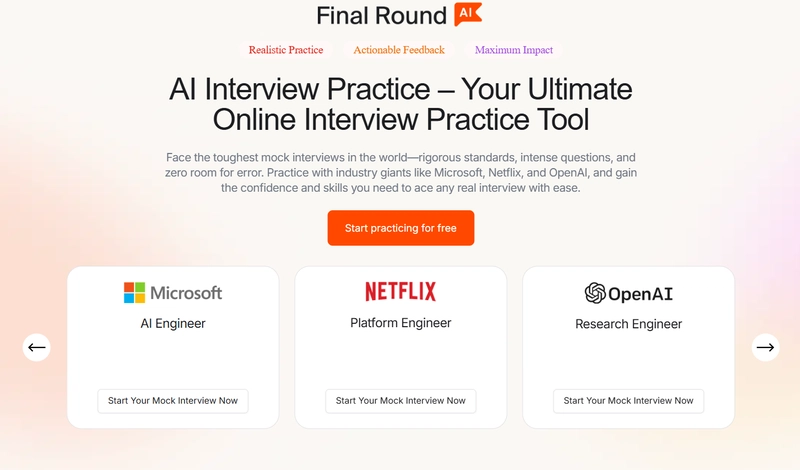This content originally appeared on DEV Community and was authored by Hadil Ben Abdallah
Interviewing for a full-stack position in 2025 is now about showing you can take something from concept to production. Getting into tech was already difficult, but the hiring process has changed drastically. Companies are no longer satisfied with candidates who can only solve abstract coding questions. They want engineers who can make the jump from whiteboard to deployment, and who can demonstrate not just theoretical knowledge, but also real-world implementation.
If you are preparing for a full-stack job in today's world, this article will take you through the modern hiring process step by step. Central to the article will be the technical expectations during the process, alongside real-world examples, as well as ways to help you stand out.
Why Interviews Changed in 2025 🤔
Just a few years back, interviews consisted mainly of LeetCode-style questions: reverse linked lists, balance binary search trees, solve shortest-path problems, etc. While these are still important, hiring managers came to realize that many developers who shine at DSA aren't as adept when it comes to actually shipping production-ready code.
Today, in 2025, interviews have evolved to assess a holistic developer skill set, including:
- Algorithmic thinking: Can you efficiently solve problems?
- System design: Can you create scalable, maintainable architectures?
- Practical coding: Can you deliver a working application with an eye towards clean code?
- DevOps & deployment: Can you deploy your solution to the cloud, monitor your solution, and scale it?
- Communication: Can you articulate trade-offs, document decisions, and lead discussions?
This reflects what is actually done by modern full-stack developers: they don’t simply write code, they implement solutions that are shipped from an idea to the deployed app.
Step 1: The Classic DSA Round 🧩
This is where virtually every interview still begins. The DSA round is assessing your raw problem-solving skills, your understanding of time and space complexity, and if you can use reasoned breakdowns to solve problems under pressure. Although the questions may seem abstract at first, it really determines whether you exhibit structured thinking that can later be applied to actual coding challenges.
🔹 Example Task:
"Given an array of meeting time intervals, determine if a person could attend all meetings."
This question evaluates:
- Your ability to sort
- Your ability to detect conflicts in intervals
- Your reasoning in Big-O
💡 Pro tip: Don't just plan for brute force. Interviewers will frequently ask “how would this scale to millions of records?” Make sure you cover time complexity and edge cases.
🎁 Bonus: Check out 30 DSA Patterns You Need to Master Before Your Next Interview in 2025
Step 2: The Real Coding Challenge 🤹🏻♂️
Now that you have demonstrated your fundamentals in problem solving, the next stage shifts into more practical coding. In this task, you will be asked to build something that resembles a real application, not another toy problem. You will be assessed on your APIs, databases, authentication and even UI/UX (if you have to build a frontend). In essence, it is a tiny version of what you would do on the job, but under a time constraint of a few hours.
🔹 Example Task:
"Build a simple task manager API with auth, where the user can create, update, and delete tasks. Deploy it to a cloud provider (AWS, Vercel or Render) and send us the link to the live version."
This style of task assesses many skills and topics:
- Backend: Can you design REST/GraphQL endpoints?
- Frontend: Can you create a usable interface?
- Database: Can you structure the tables and create queries correctly?
- DevOps: Can you deploy under time constraints?
In 2025, tools such as Next.js, Django Ninja, and Serverless functions are commonplace for these take-home assignments. If you can set up CI/CD (GitHub Actions, GitLab CI) or even basic testing, you level up.
🎁 Bonus: Check out 10 genius technical projects that can 10x your resume

Try Final Round AI for FREE today! 🔥
Step 3: System Design for Full-Stack Developers 🎨
At this point in the interview process, the interviewers are checking if you're able to think beyond code snippets and think of complete systems. For example, full-stack engineers need to think about how applications scale, how data flows from one service to another, and how to make design decisions about the architecture. It's less about drawing the "perfect diagram" and more about showing that you can think about the applicable trade-offs in a technology.
🔹 Example task:
"Design a scalable chat application that allows one-to-one messaging and group chats, with real-time updates."
What are the interviewers looking for?
- Database selection: SQL vs NoSQL (PostgreSQL or MongoDB?)
- Real-time communication: WebSockets, GraphQL subscriptions, event-driven architecture?
- Scalability: Horizontal scale, Redis cache, Load Balancing
- Security: Authentication, Authorization, message encryption?
Many organizations are going to want to see how you rationalize a candidate's decisions about trade-offs instead of jumping directly into microservices. For example:
"Would you choose WebSockets or Server-Sent Events, why, and how would you accommodate message persistence?"
These discussions are more important than coming up with the "perfect" diagram.
🎁 Bonus: Check out 40 System Design Questions That Could Land You a $150K Job in 2025
Step 4: Deployment & DevOps Round 🎯
This is the moment to set apart average candidates from excellent candidates. Any developer can code, but only some can deploy applications, track them, and ensure reliability in production. It's 2025, and Knowing how to deploy is no longer a "nice-to-have", it is now a fundamental skill. Recruiters expect you to take an app that runs locally and deploy it to the cloud at scale.
You can expect questions like:
- Can you deploy an app to AWS, Vercel, or Docker containers?
- Do you know how to manage environment variables in a secure way?
- Can you put logging and monitoring in place (think of, for example, Prometheus, Grafana, Datadog)?
- How would you deploy updates with zero-downtime?
🔹 Example Task:
"Please take the API that you built earlier and deploy it using Docker + Kubernetes. Show us how you would ensure high availability."
You don't have to be a DevOps expert, however, having foundational knowledge of CI/CD pipelines, containers, and cloud deployment is essential.
Step 5: The Behavioral & Soft Skills Interview 🗣
The final part of the process may feel less technical, but the behavioral round is just as important. By 2025, companies are aware that full-stack developers often collaborate across multiple teams, design, QA, DevOps, product and they are looking for engineers who communicate clearly, resolve conflict, and explain technical trade-offs. This round will evaluate how you think under pressure and how you work with others.
🔹 Example Task:
"Tell me about a time when you had to debug a critical production issue under pressure. What did you do, and how did you communicate with your team?"
This is not about having the “right” answer, it is about demonstrating maturity and problem-solving under stress.
🎁 Bonus: Check out Top 30 Behavioral Interview Questions That Can Make or Break Your Interview
How to Prepare in 2025 👨🏻💻
To pass full-stack interviews today, you need multidimensional preparation.
Here's a plan to follow:
- Practice DSA: Use platforms like LeetCode, Codeforces, or HackerRank. It's important to practice a breadth of questions, but you should focus on depth. As a beginner, don't worry too much about speed.
- Build and deploy actual projects: Every role you interview for, will want to see your portfolio, but if you can show them deployed apps via Vercel, AWS, or Render, it will impress them more than you can explain in writing.
- Practice system design: Study architecture patterns (monolith vs. microservices, caching strategies, etc.).
- Practice DevOps: Familiarize yourself with Docker basics, CI/CD pipelines, and cloud deployment for your projects.
- Practice your communication skills: Do some mock interviews with your peers, but focus on your explanation and reasoning.
Final Thoughts 🎉
The full-stack interview in 2025 is no longer about a single skill, it’s about being a complete engineer. Companies want people who can move from DSA to deployment, solving problems from scratch and delivering production-ready solutions.
If you’re preparing, don’t just memorize coding patterns. Instead, simulate the real job: build projects, deploy them, document them, and share them.
Take an idea from concept to production, and show hiring managers exactly what they want to see 🔥
| Thanks for reading! 🙏🏻 Please follow Hadil Ben Abdallah & Final Round AI for more 🧡 |
|---|
This content originally appeared on DEV Community and was authored by Hadil Ben Abdallah
Hadil Ben Abdallah | Sciencx (2025-08-25T06:38:57+00:00) 🚀 From DSA to Deployment: What a Real Full-Stack Job Interview Looks Like in 2025. Retrieved from https://www.scien.cx/2025/08/25/%f0%9f%9a%80-from-dsa-to-deployment-what-a-real-full-stack-job-interview-looks-like-in-2025/
Please log in to upload a file.
There are no updates yet.
Click the Upload button above to add an update.



